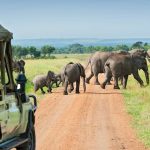
Most tourists travel to Africa with a travel company. They are always accompanied by an experienced and professional tour guide that advises them about guidelines and how to behave safely and appropriately. Be that as it may, in the event that you are a solo traveler like us and choose to hire a vehicle and complete a self-drive safari, odds are that no one will disclose to you what not to do on an African safari. So how is one to learn legitimate safari behavior?
Our main concern when we go on a self-drive tour in Africa is to know about our environment and to not do anything that may harm or trouble wildlife in any way. The fact is that it is very easy to get carried and to overlook how imperative this is.
Watching wildlife in Africa is such an amazing and exceptional experience, it is likely that a few tenets will be broken unintentionally. Most of these tenets may seem like common sense while others may really appear to be unreasonable. For instance, some first-time wildlife travelers actually have a brief that feeding a wild animal is a decent deed when actually it’s very harmful. On the events we’ve ended up breaking the guidelines, we ended up feeling extremely awful about it. We’d get a kick out of the chance to enable you to gain from our missteps. All things considered, it wouldn’t bode well to make harm to the very animals you’ve voyage most of the way around the world to see, would it?
Learn how to stay away from this list of no-no’s and you will end up being a boss of safari manners!
Give animals Room to Work
When driving in the national park in your safari vehicle, don’t get too near to the animals. It doesn’t make a difference how cool the sighting is. Everyone needs their own space, even animals. I get agitated when people invade my own space, yet I won’t step on your vehicle if I get upset. Some elephants may.
Wildlife is only that: wild. They are not pets, and love all people they carry on erratically and are possibly unsafe. You don’t comprehend what they may think, and you can’t know how they’ll respond. Give them enough room so they can act normally, and they feel safe.
Don’t Contribute to “Lion Jams”
 These normally happen in the national parks and they are always caused by sighting of animals like leopard, lion, elephant, rhino, or other animals near the top of every wildlife watcher’s list. In the event that you stop at this sort of sighting, be aware of other tourists trying to watch. Most tourists will pull over wherever they see fit, without considering that they may be blocking other tourists. Be nice to others. We know, it’s your first time seeing such an animal and you’re extremely eager to get an impression.
These normally happen in the national parks and they are always caused by sighting of animals like leopard, lion, elephant, rhino, or other animals near the top of every wildlife watcher’s list. In the event that you stop at this sort of sighting, be aware of other tourists trying to watch. Most tourists will pull over wherever they see fit, without considering that they may be blocking other tourists. Be nice to others. We know, it’s your first time seeing such an animal and you’re extremely eager to get an impression.
But here are two suggestions for doing it right.
One, work your way into the mess, snap a couple of photographs, watch for two or three minutes and afterward proceed onward. Don’t worry; you are certain to have more awesome sightings! There’s nothing more irritating than hearing the noisy hum of a car engine next to you while you’re trying to enjoy a peaceful moment with a napping cheetah.
A second alternative is to stop your car at a comfortable distance from the jam and make yourself a sandwich. Tourists have surprisingly limited ability to focus and when the animal sets down for a rest or ducks behind a bush, they get exhausted quickly. In the event that you are tolerant, you may wind up having an astonishing sighting all to yourself.
Sharing Information on a Wildlife Sighting Might Be the Best Thing You Do All Day
Some of the time when you are alone at a sighting other tourists will stop and ask you what you are taking a gander at.
Most tourists are hesitant to share this information. They need the sighting all to themselves. In any case, recall that we’re all here for a similar reason, to get a look into the lives of stunning animals we once in a while get the chance to see. Inform other tourists concerning your sightings and offer a few hints. You may very well fill somebody’s heart with joy.
You’ll be astonished that it is so easy to make “safari friends”, people that you see consistently on your drives who will impart great information to you as well.
Stay Inside Your Vehicle at All Times
In most national parks in Africa there is one fundamental rule: don’t get out of your safari vehicle when you on a self-drive trip. This isn’t just a basic matter of proper safari decorum. In case you get captured by a park ranger outside your vehicle, you will presumably be expelled from the national park. On the off chance that you get captured by a lion or leopard outside your vehicle, you may never be heard from again! There are a few places inside national parks where you are permitted to leave your vehicle, as in picnic areas or amidst long bridges. These areas will be unmistakably marked. In the event that you don’t see one of these signs, don’t leave your vehicle! Pretty simple, isn’t that so?



